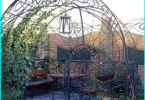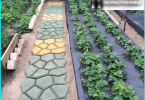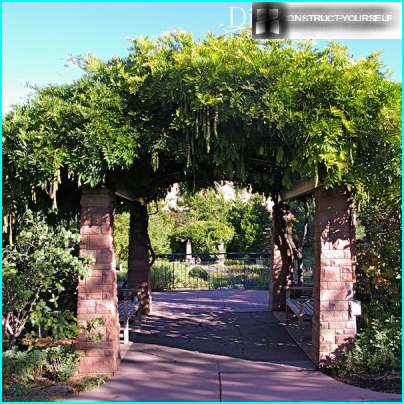
How permanent pool is beautiful and useful in rehabilitation, as it is difficult to care for. The water must be constantly cleaned, filter, get rid of the incoming trash. But if the top structure is covered with a transparent floating over the water construction of the pavilion, the care becomes simpler. Even those owners who have mounted the Cup open and eventually finished it over the pool enclosure with their hands.
The contents
Why is it necessary pavilion?
Completed pool pavilion, the host will receive the following «bonuses»:
- The water will be less to evaporate from the surface.
- Significantly reduced heat loss, and therefore the cost of heating the water. Besides, it will lengthen the time of the bathing season.
- In the pool won’t get dirty caused by precipitation and wind-blown dust, debris, leaves, and the owner will save on filtration and purification of water by chemical means (if the pavilion is closed).
- The ultraviolet rays collide with the barrier and fall into the pool’s refracted. And hence their damaging effect on the sides and bottom will become weaker, which will increase the lifetime of the materials the pool.
- In winter the temperature under the pavilion is higher than outside, so designs do not need to be tested too low temperatures, making some of the materials and the system of application of water can come into disrepair.
Selection rules for the design of the pavilion
To build a pavilion for the pool with their hands, it is necessary to determine its design.
Low pavilions
If the pool is used occasionally, but the rest of the time is idle, then the cheapest option would be a low pavilion with a maximum height of meters. He will perform the most important function – the protection of water against sun, rain and debris. And if the owners don’t plan to dive off the sides, it is enough to make sliding the section and through it into the water.
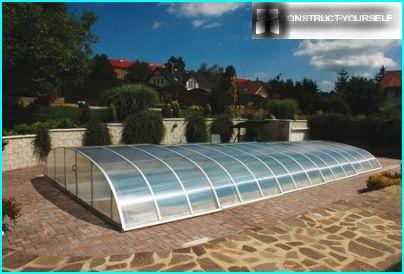
Low pavilions convenient, if the pool is used only during the summer season
There are designs with a height of about two meters. They are for convenience mounted in the side door. Is this version of the pavilion on the principle of conventional greenhouses with the use of metal profiles and polycarbonate sheets. You can, of course, is polycarbonate to pull the plastic film, but the aesthetic appearance will suffer, and the wear resistance of the coating film is weak.
High pavilions
The high pavilions are about three metres in height and are used not only to protect the pool, but also serve as a beautiful recreation area for the owners. Greenhouse climate allows to build perimeter of the bowl the floral arrangements, put chairs or rocking chairs for relaxing. But in this case, if the boundaries of the pavilion is much wider than the size of the bowl.
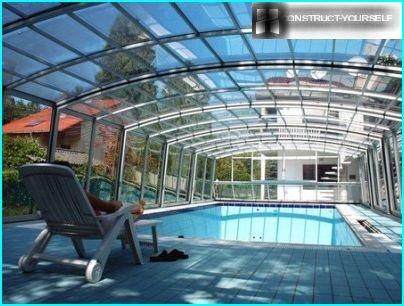
High pavilions replaced owners traditional gazebos, because they have enough space to relax and warm enough even in winter
The cheapest option is the pavilion, which is built on the perimeter of the Cup, speaking to tens of centimeters. It can be fully closed or half closed. Semi-closed option protects the bowl or on only one side (often the side where the wind blows), or the ends, leaving an open middle, or on the sides, leaving the ends open. This pavilion will provide maximum protection, but a barrier to wind and debris will create, and the owners will get a shadow area in which to hide from the scorching sun.
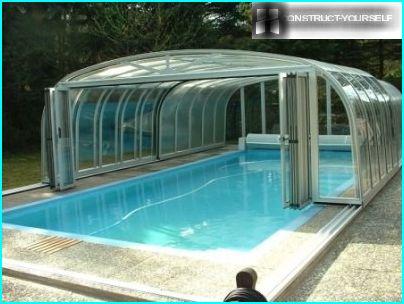
Semi-enclosed pavilion only protects part of the basin, and it is better to mount side wind or gardens
Sliding design
At any height the pavilion enhances the comfort level of the system of sliding partitions. Their Foundation is a system of rail (as in closets-Komandor Islands), on which the sections can move and go one after another. Sliding them to one end, the owners get the awning to create shade, and in the case of precipitation can quickly insulated Cup.
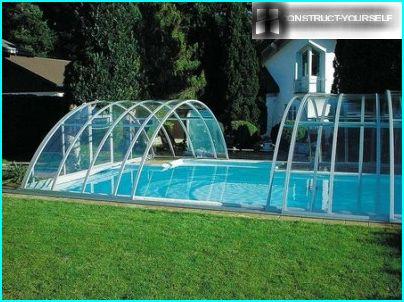
Sliding or telescopic pavilions and move along the rail and can be completely out of the water pool area
The choice of the form of the pavilion depends on the bowl of the pool. For round bowls use a dome-shaped model for rectangular – shaped «P» or hemisphere. The most complex are the pools of irregular shapes. They create asymmetric «sheds».
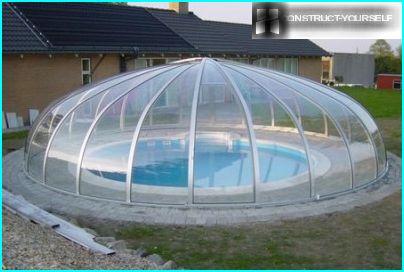
For round bowls the most successful form of the pavilion is the dome
Technology of creation of the pavilion with his own hands
From an economic point of view, the creation of the pavilions of the own forces is justified, but if you have no experience, the installation of tall structures may be delayed for a few weeks. However, some gardeners simply have no choice, because the bowl of irregular shape to find the appropriate «the roof» it is not always possible. So, it is necessary to buy the materials and build the pavilion. Look at how this is done in a semi-enclosed design made of polycarbonate.
Determined by the materials and form
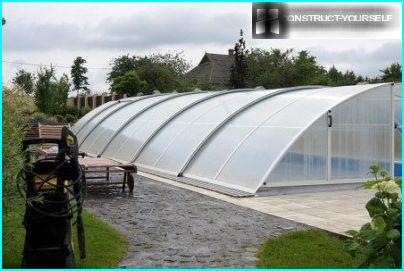
Pavilion polycarbonate meets on the principle of conventional greenhouses
For coating we use polycarbonate, which usually cover greenhouses. A frame will make the core tube.
To minimize the cost and complexity of installation, make the design of open ends, put on the Foundation of the pool or finish and leave the possibility to disassemble for the winter.
Swimming a great height is not necessary, so it is enough two-meter pavilion.
Fill the Foundation
Despite the seeming ease, polycarbonate and metal profiles have a considerable weight, therefore, the Foundation for the pavilion has to be reliable. If around the pool you have already created a Seating area and tile flooring, then you can mount right on it.
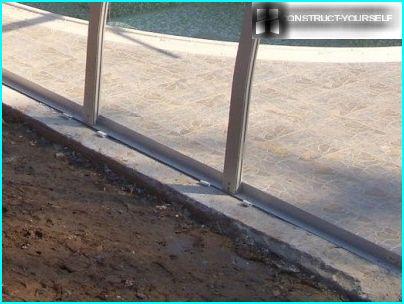
From the design of the pavilion, the Foundation must be for another 7 feet to securely hold the entire load
The rest of the owners will have to pour the Foundation two feet thick, the width of which should be from the base of the frame is approximately 7 inches in sides. The concrete must be reinforced, laying out cells-squares of side 20 cm.
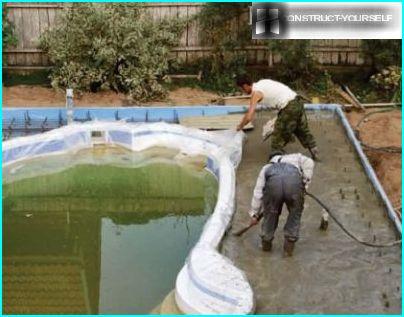
The Foundation for the pavilion should be thick and durable, because the weight of the whole structure can reach a ton or more
Frame
For the major arcs of the frame need a wider pipe, which would be possible to attach two edges of adjacent sheets of polycarbonate. Its length is 1 height (2 m) + width of pool.
The pipes have to bend the arches. It is better to entrust this to the professionals, and who have welding to do. The part of the pipe that needs to bend, cut on three sides, the circular saw, carefully bend, fixing the edges in a vise, and after all the cuts weld. The welding zashlifovyvajut.
Fixed to the Foundation base frame using bolts.
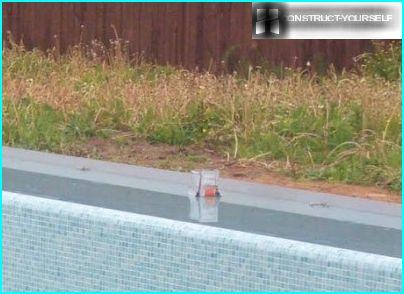
The base frame attachable to the Foundation or the finishing of the pool with bolts
Put arc also locking bolts and nuts (If the option is non-separable – it is possible to brew). The distance between the arcs — meter.
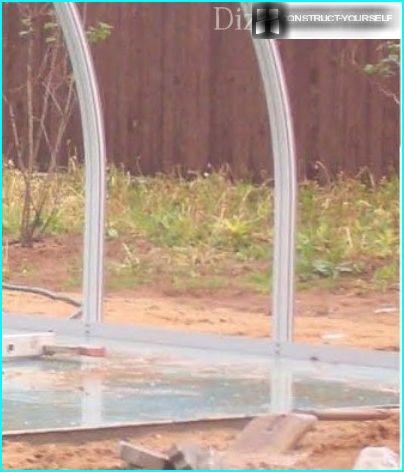
All arcs attached to the base with bolts
Between arcs, fix the ribs, alternating 2 ribs, 3 to span.
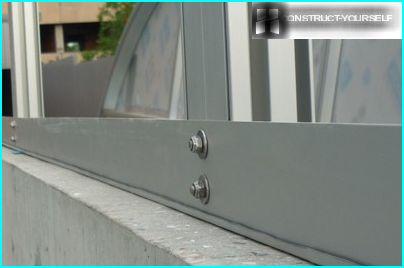
Arc take on double bolts for reliability
Ready frame treated anti-corrosion agents and paint in desired color.
Sheathed polycarbonate
Planned on the polycarbonate sheet (the color and thickness of your choice) where they will be attached to the pipe and drill a hole. They should be slightly bigger than thickness of screws, because in the heat of the polycarbonate «plays», and should be a margin for expansion.
Ready to frame sheathe sheets of polycarbonate. Fastened the sheets with screws, and under the cap it is necessary to enclose the metal (galvanized!) washers to cover the holes.
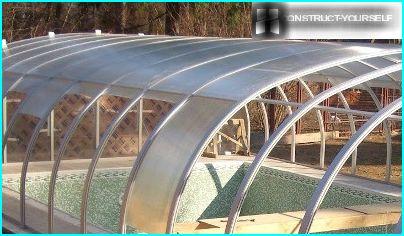
Carbonate sheets should lie on the core tube butt
From within all locations of fasteners and joints with sealant coat.
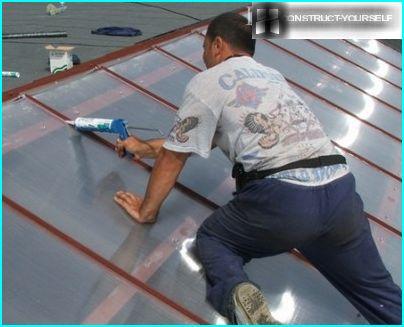
All joints and fasteners lubricated with sealant
The concrete base should be insulated on both sides from water and sediment by using decorative finishes granite, tile, etc.
Note that the more you disassemble the figure, the faster it will wear out. So think, does it make sense to remove the pavilion before each winter. This is justified, if only in winter, the cottage will be empty, and no one will clean off the snow from the pavilion in case of heavy snowfall.

